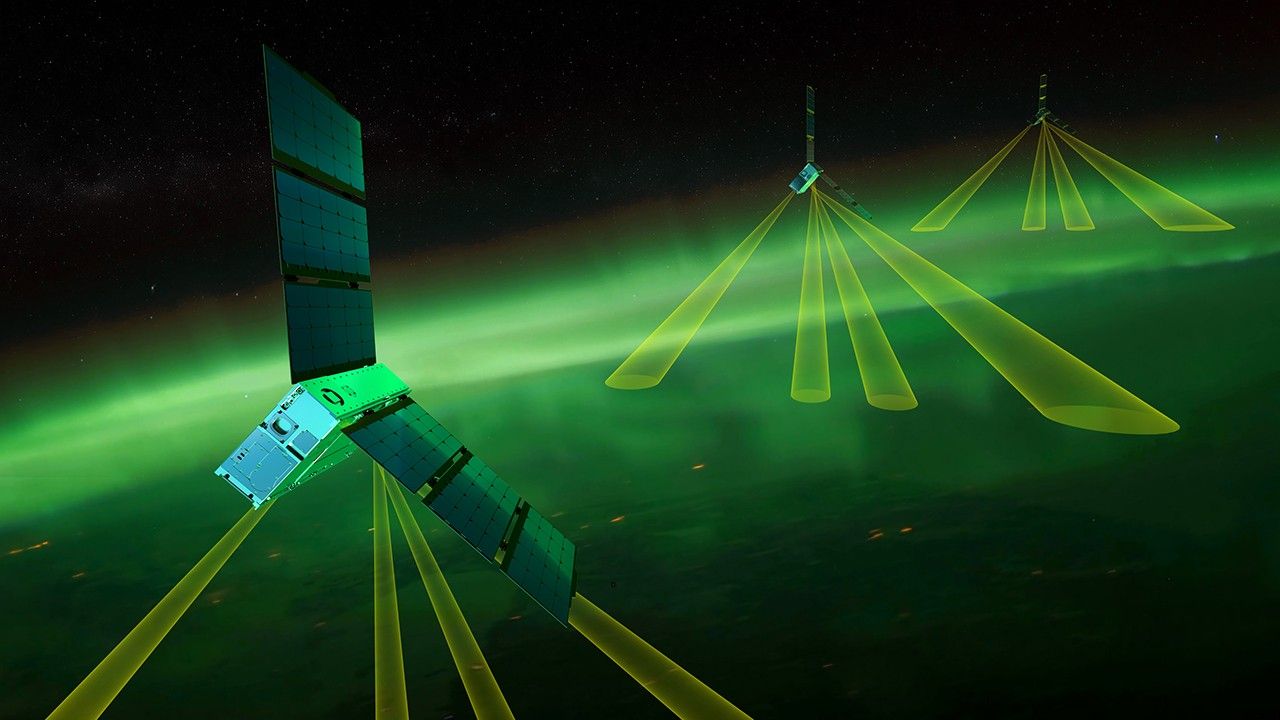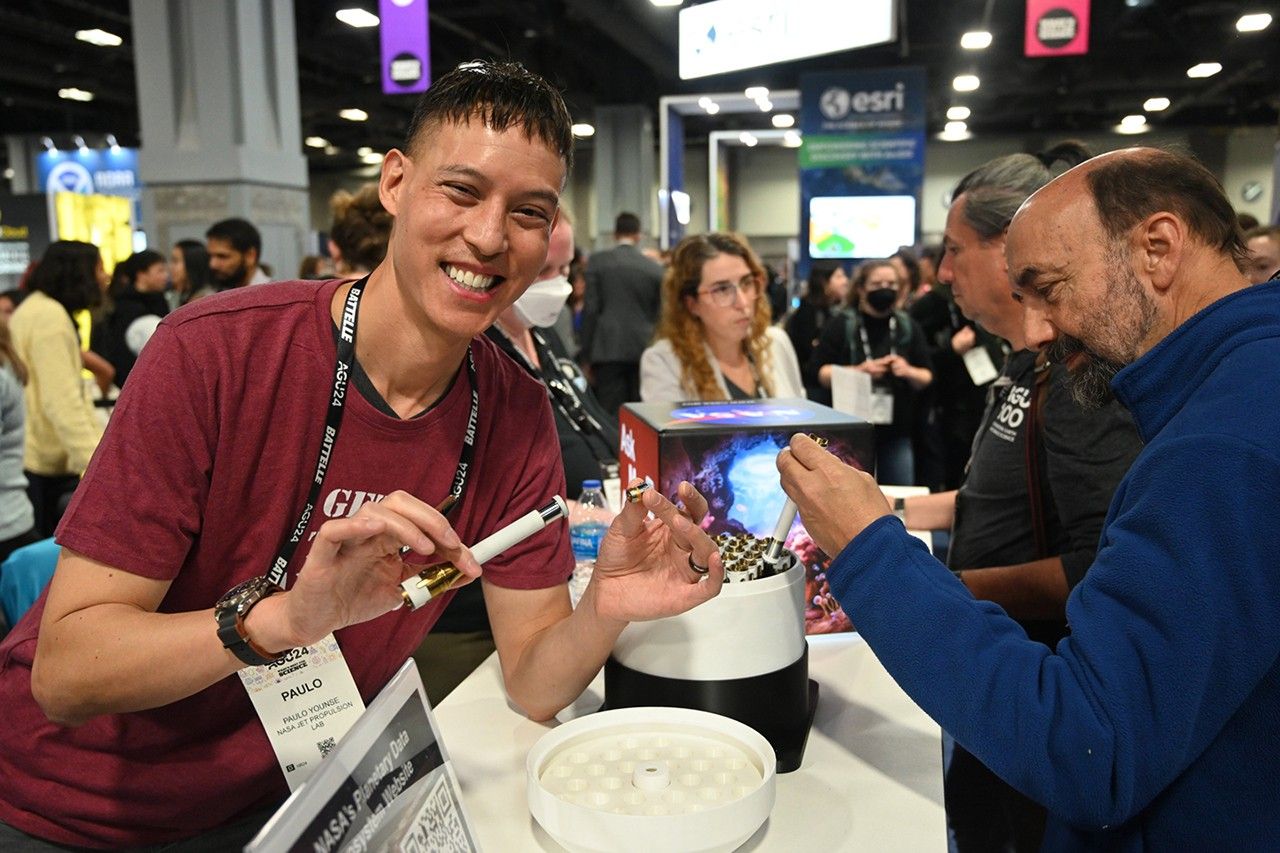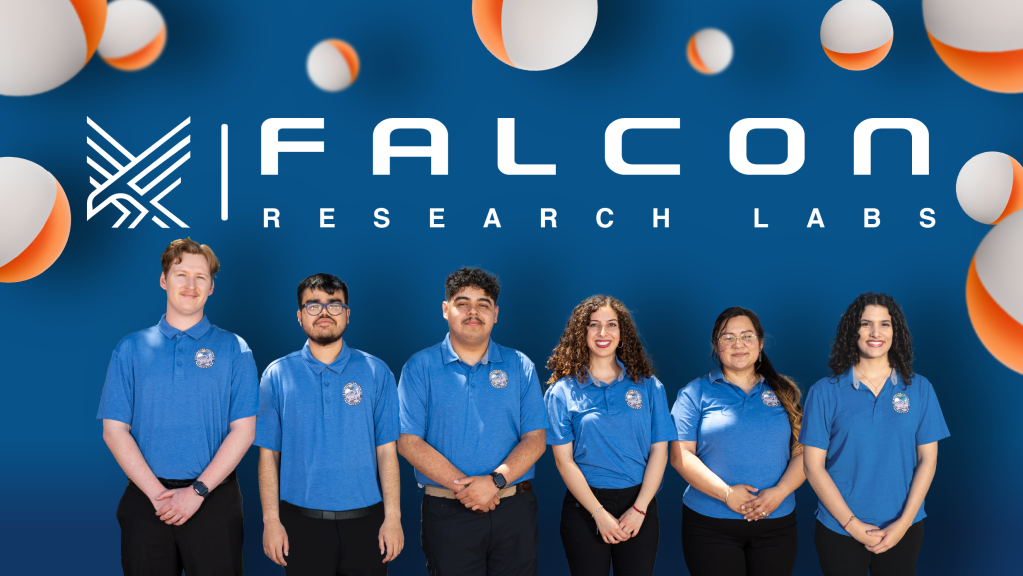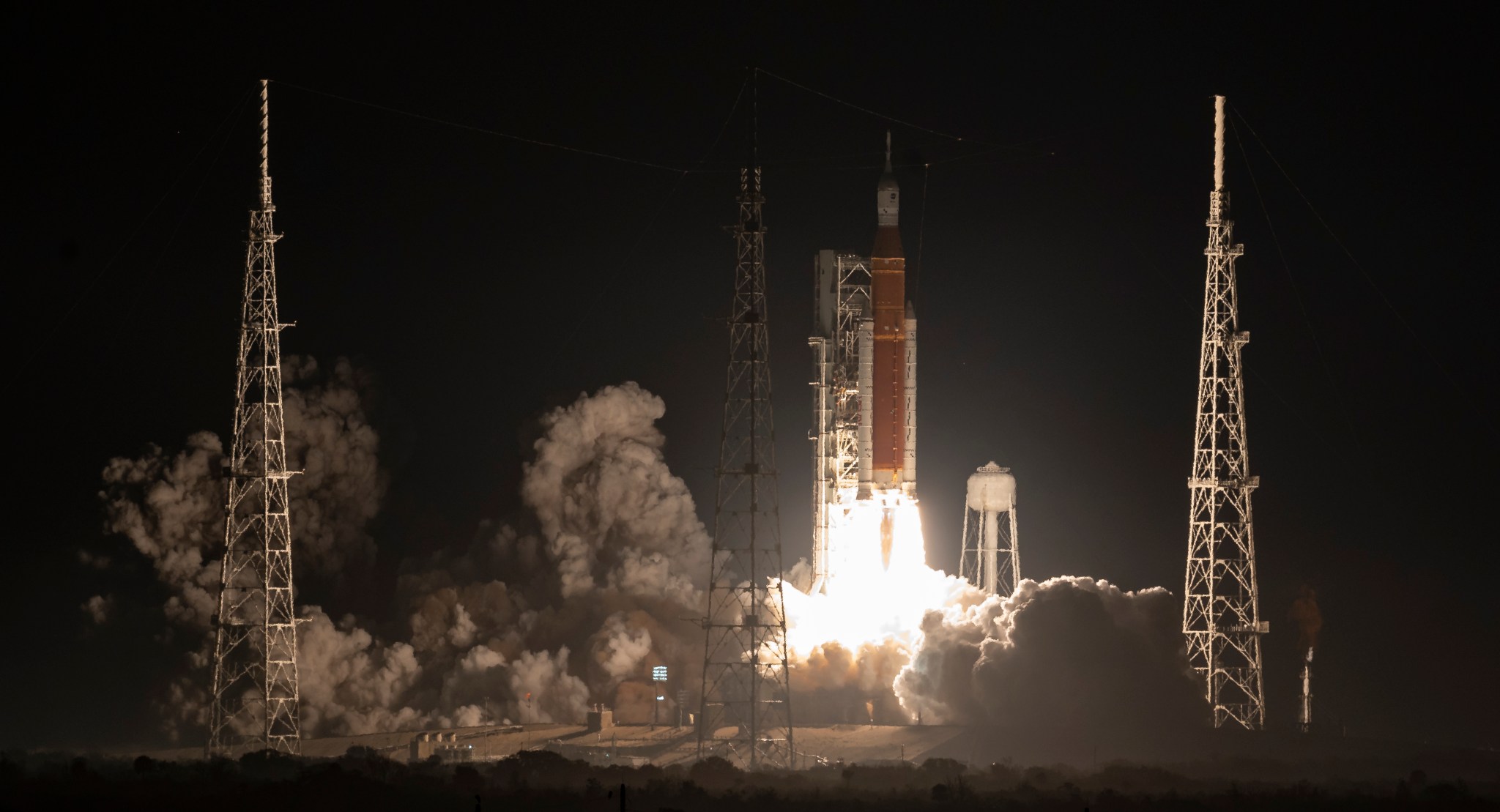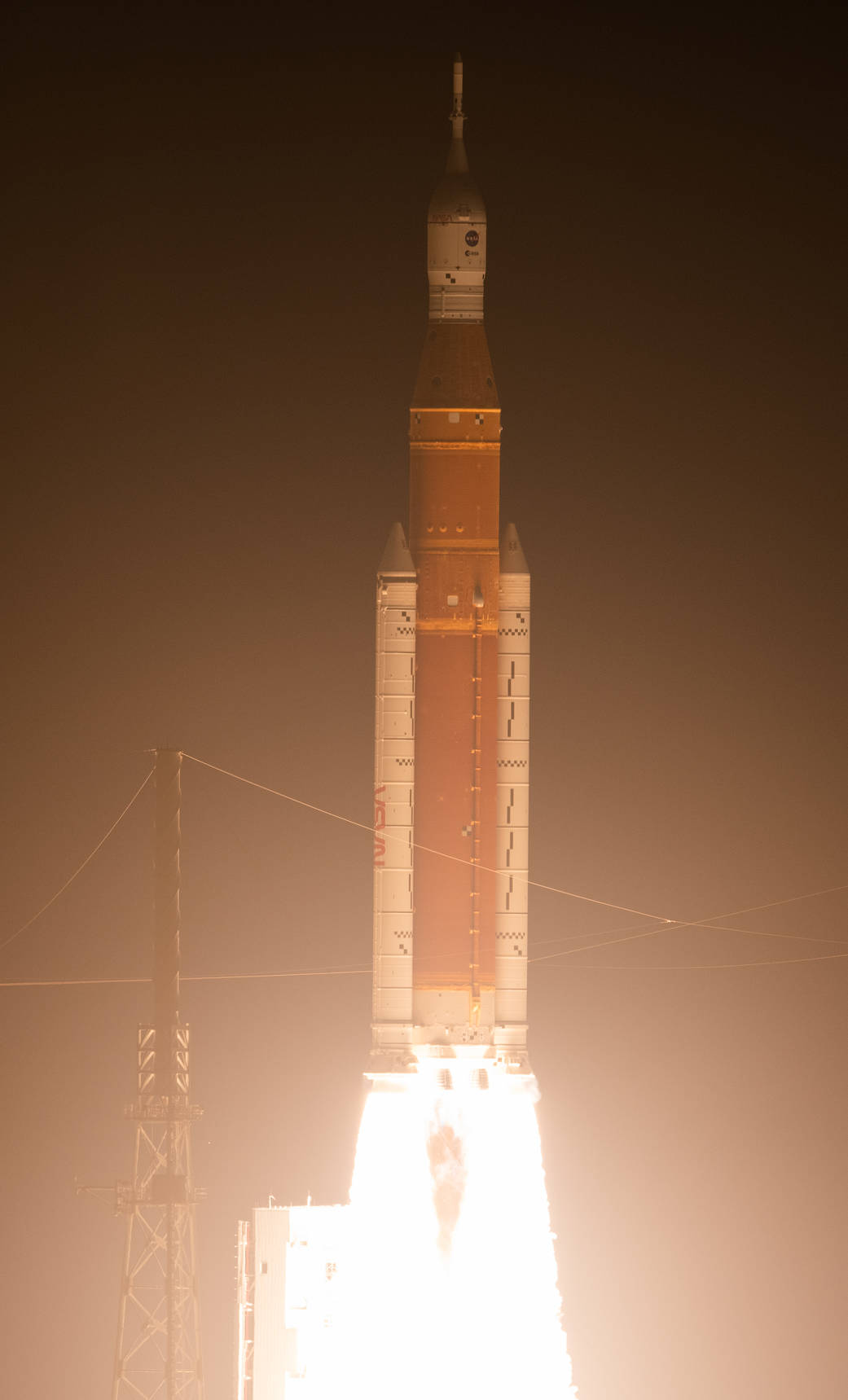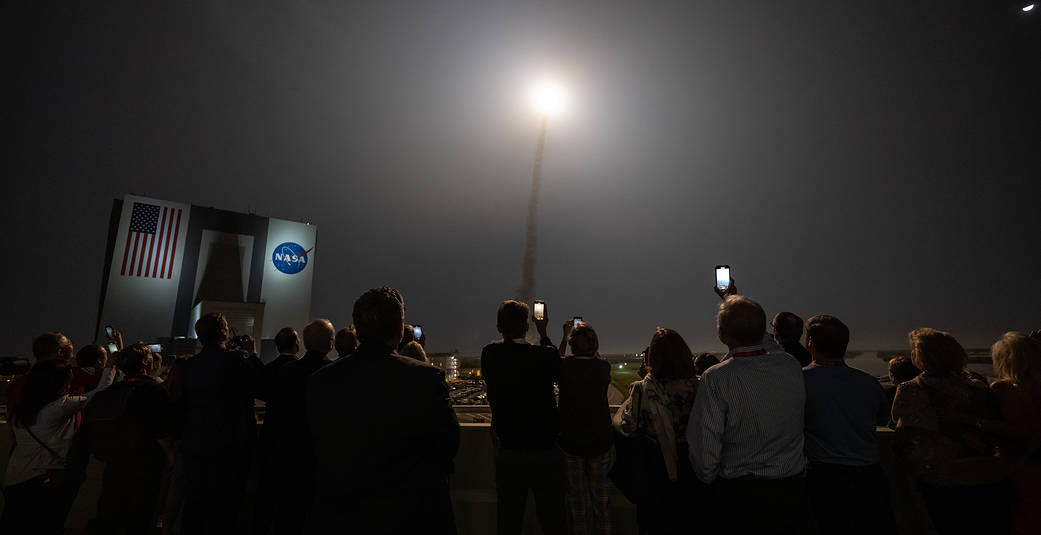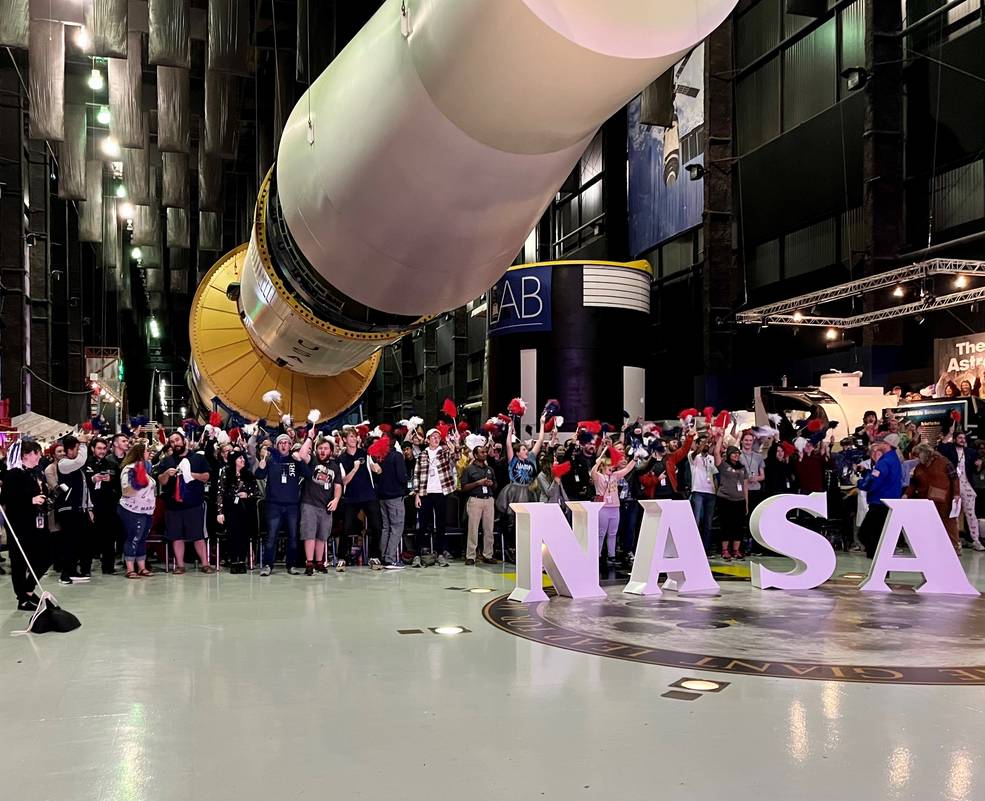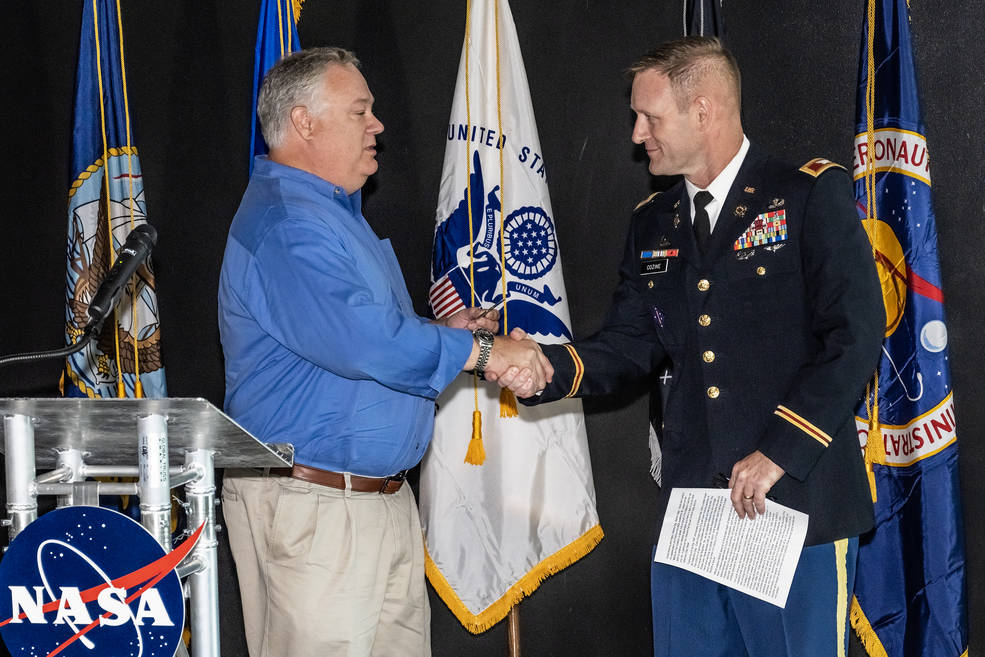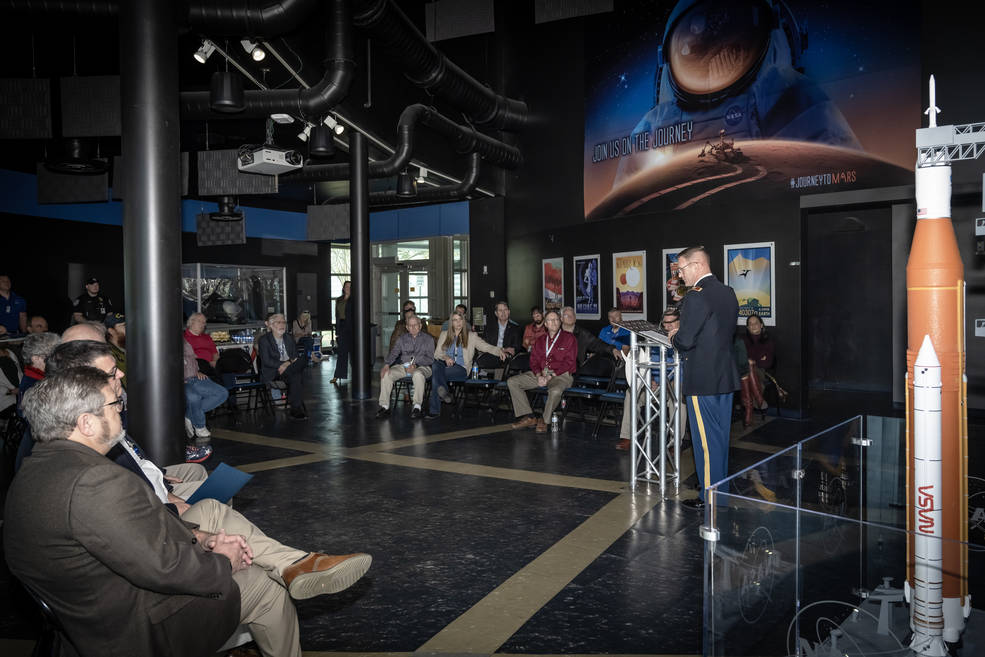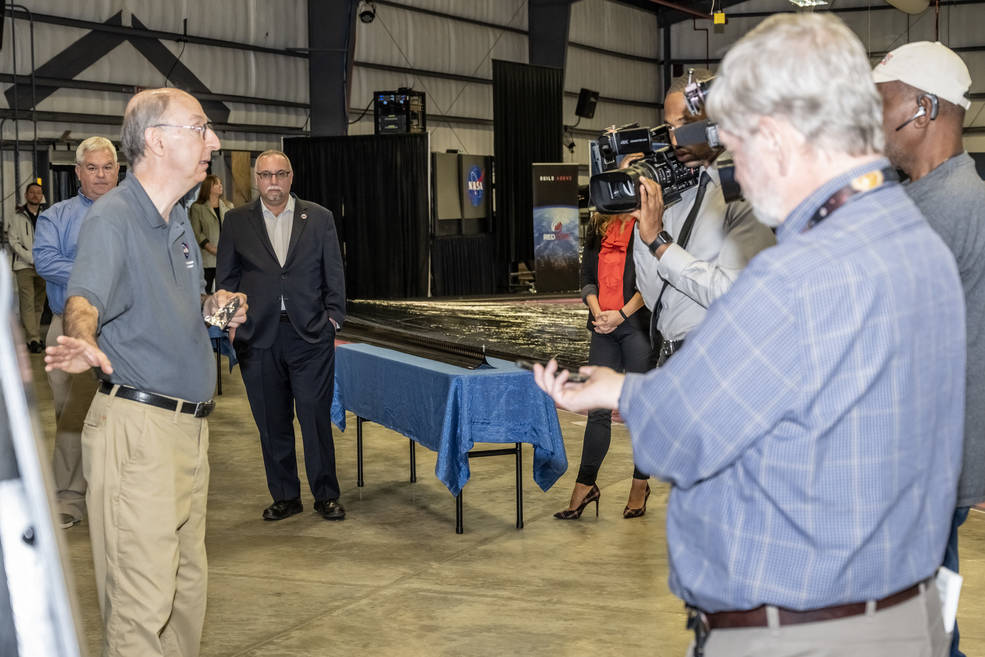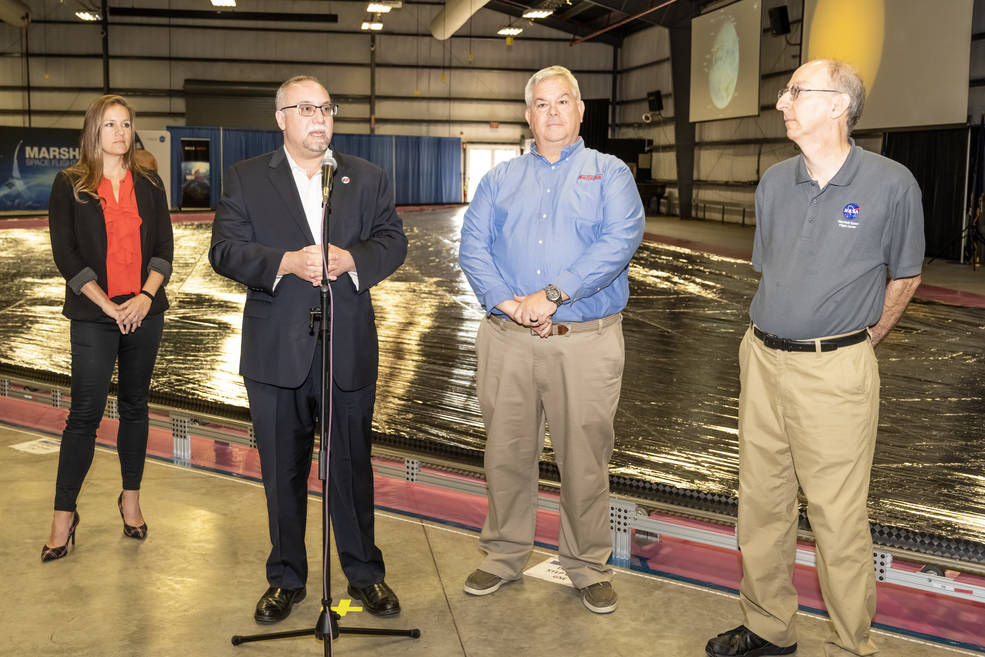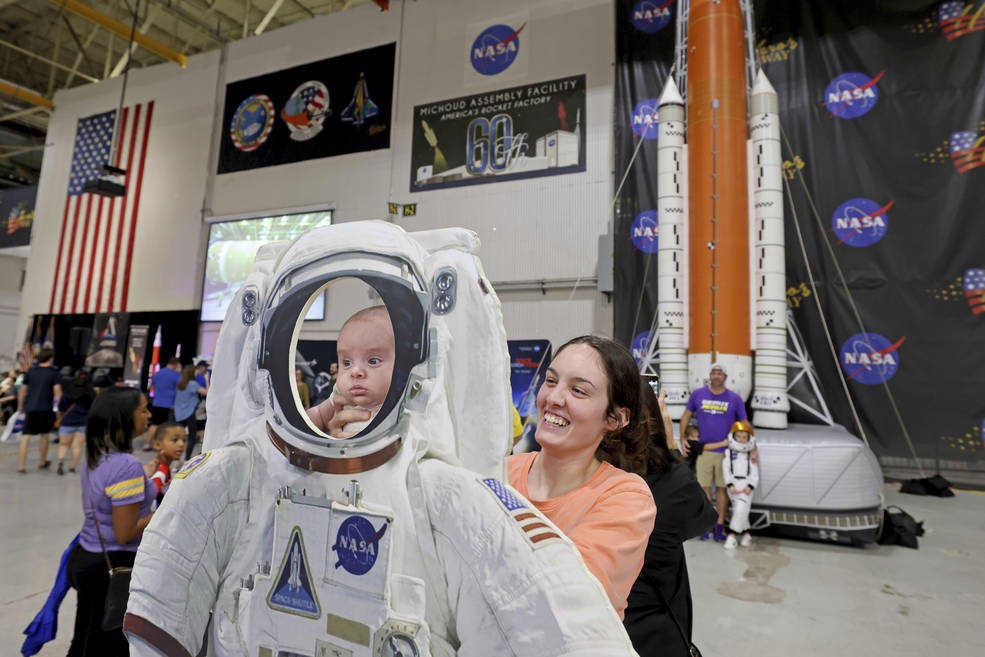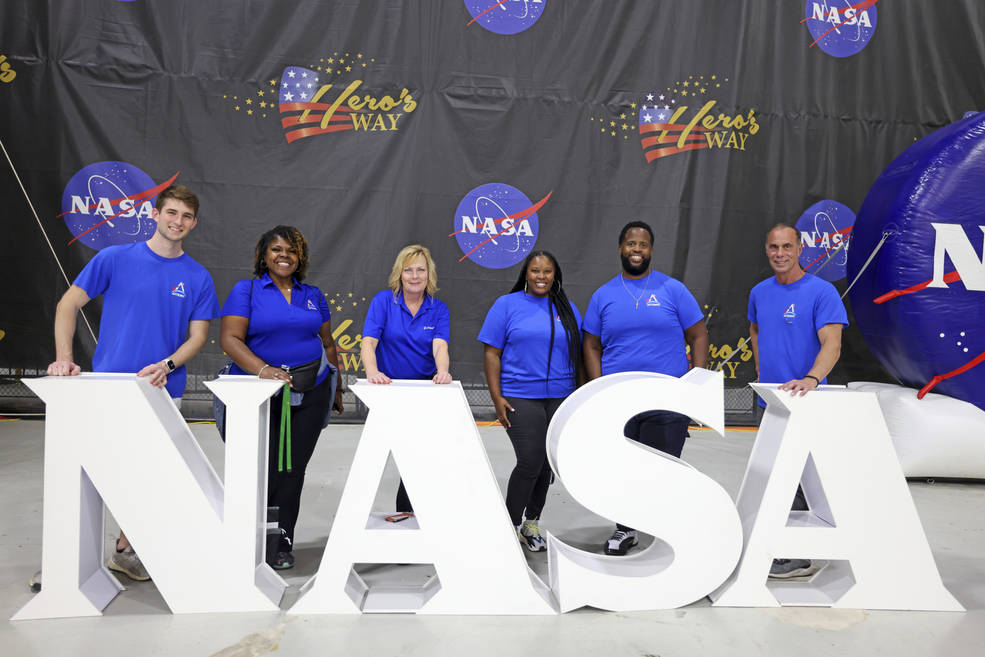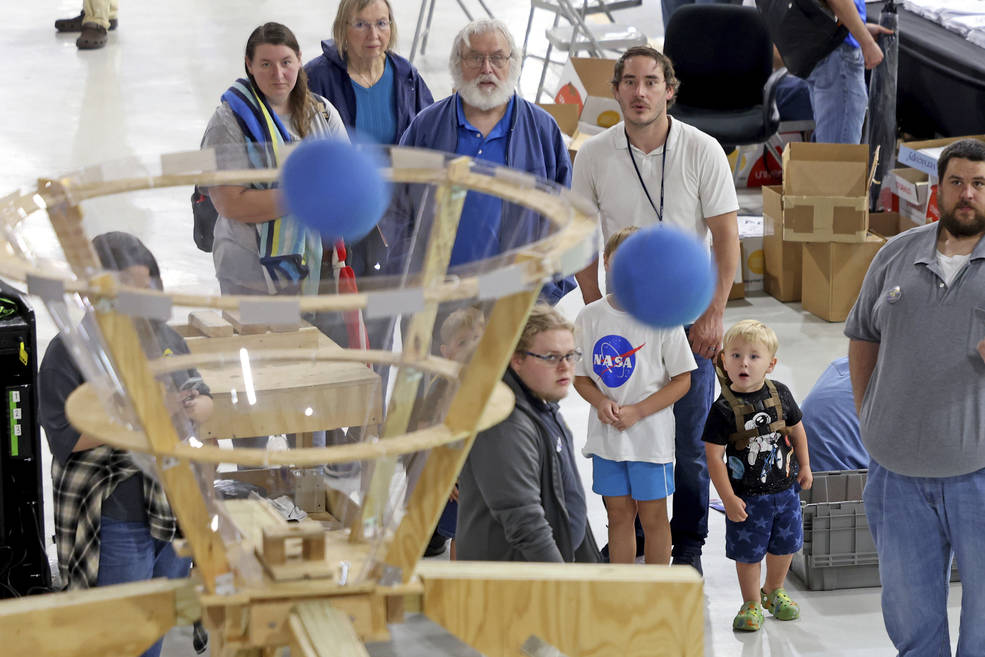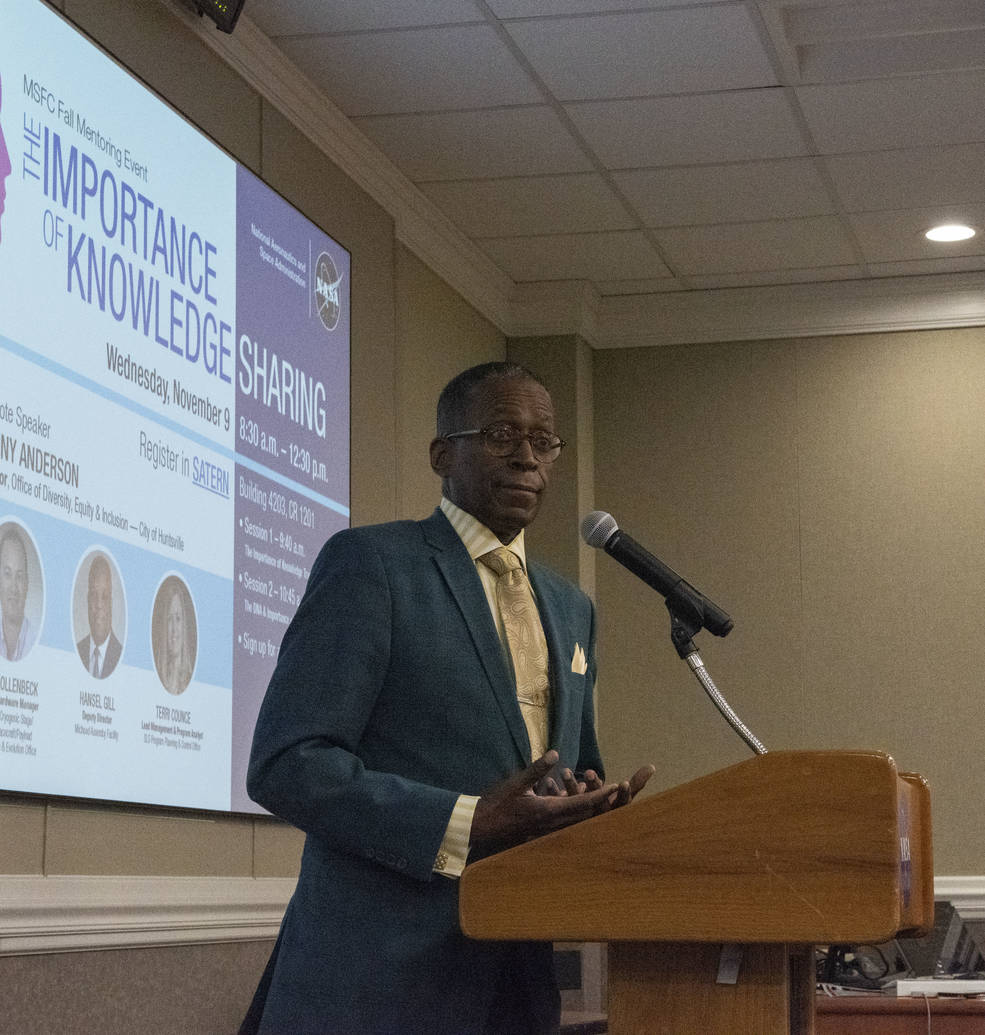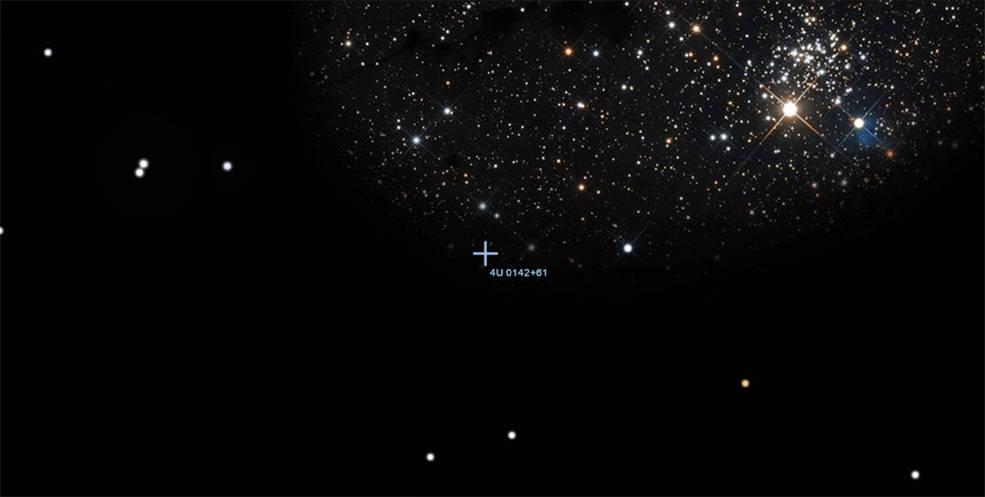The Marshall Star for November 16, 2022.
In This Week’s Star
- Liftoff! NASA’s Artemis I Mega Rocket Launches Orion to Moon
- Center Honors Veterans with Veterans Recognition Program
- Marshall Event Displays Largest Solar Sail Section Ever Deployed
- Rocket Science in 60 Seconds: How Is Propellant Loaded into NASA’s SLS Moon Rocket?
- 50 States: Technical Services for Artemis
- Thousands Gather to Celebrate Family Day at Michoud
- Center hosts Fall Hybrid Mentoring Event
- IXPE Finds Powerful Magnetic Fields and Solid Crust at Neutron Star
- LOFTID Demonstration Featured on ‘This Week at NASA’
Liftoff! NASA’s Artemis I Mega Rocket Launches Orion to Moon
Following a successful launch of NASA’s Space Launch System (SLS), the most powerful rocket in the world, the agency’s Orion spacecraft is on its way to the Moon as part of the Artemis program. Carrying an uncrewed Orion, SLS lifted off for its flight test debut at 1:47 a.m. EST/12:47 a.m. CST Nov.16 from Launch Pad 39B at NASA’s Kennedy Space Center.
The launch is the first leg of a mission in which Orion is planned to travel approximately 40,000 miles beyond the Moon and return to Earth over the course of 25.5 days. Known as Artemis I, the mission is a critical part of NASA’s Moon to Mars exploration approach, in which the agency explores for the benefit of humanity. It’s an important test for the agency before flying astronauts on the Artemis II mission.
“What an incredible sight to see NASA’s Space Launch System rocket and Orion spacecraft launch together for the first time. This uncrewed flight test will push Orion to the limits in the rigors of deep space, helping us prepare for human exploration on the Moon and, ultimately, Mars,” said NASA Administrator Bill Nelson.
After reaching its initial orbit, Orion deployed its solar arrays and engineers began performing checkouts of the spacecraft’s systems. About 1.5 hours into flight, the rocket’s upper stage engine successfully fired for approximately 18 minutes to give Orion the big push needed to send it out of Earth orbit and toward the Moon.
Orion has separated from its upper stage and is on its outbound coast to the Moon powered by its service module, which is the propulsive powerhouse provided by ESA (European Space Agency) through an international collaboration.
“It’s taken a lot to get here, but Orion is now on its way to the Moon,” said Jim Free, NASA deputy associate administrator for the Exploration Systems Development Mission Directorate. “This successful launch means NASA and our partners are on a path to explore farther in space than ever before for the benefit of humanity.”
A series of 10 small science investigations and technology demonstrations, called CubeSats, will deploy from a ring that connected the upper stage to the spacecraft. Each CubeSat has its own mission that has the potential to fill gaps in our knowledge of the solar system or demonstrate technologies that may benefit the design of future missions to explore the Moon and beyond.
Orion’s service module performed the first of a series of burns to keep Orion on course toward the Moon approximately eight hours after launch. In the coming days, mission controllers at NASA’s Johnson Space Center will conduct additional checkouts and course corrections as needed. Orion is expected to fly by the Moon on Nov. 21, performing a close approach of the lunar surface on its way to a distant retrograde orbit, a highly stable orbit thousands of miles beyond the Moon.
For Artemis I updates, visit here. Watch the post-launch news conference here.
“The Space Launch System rocket delivered the power and performance to send Orion on its way to the Moon,” said Mike Sarafin, Artemis I mission manager. “With the accomplishment of the first major milestone of the mission, Orion will now embark on the next phase to test its systems and prepare for future missions with astronauts.”
The SLS Program is managed by NASA’s Marshall Space Flight Center.
The SLS rocket and Orion spacecraft arrived at Kennedy’s Launch Pad 39B on Nov. 4 where they rode out Hurricane Nicole. Following the storm, teams conducted thorough assessments of the rocket, spacecraft, and associated ground systems and confirmed there were no significant impacts from the severe weather.
Engineers previously rolled the rocket back to the Vehicle Assembly Building (VAB) Sept. 26 ahead of Hurricane Ian and after waving off two previous launch attempts Aug. 29 due to a faulty temperature sensor, and Sept. 4 due to a liquid hydrogen leak at an interface between the rocket and mobile launcher. Prior to rolling back to the VAB, teams successfully repaired the leak and demonstrated updated tanking procedures. While in the VAB, teams performed standard maintenance to repair minor damage to the foam and cork on the thermal protection system and recharge or replace batteries throughout the system.
Artemis I is supported by thousands of people around the world, from contractors who built Orion and SLS, and the ground infrastructure needed to launch them, to international and university partners, to small businesses supplying subsystems and components.
Through Artemis missions, NASA will land the first woman and the first person of color on the surface of the Moon, paving the way for a long-term lunar presence and serving as a steppingstone for astronauts on the way to Mars.
View more photos of Artemis I here.
Read more about Marshall’s Artemis contributions here.
Center Honors Veterans with Veterans Recognition Program
Wes Brown, left, manager of the Office of Strategy at NASA’s Marshall Space Flight Center, greets Redstone Arsenal Garrison Commander Col. Brian Cozine, the guest speaker for the 2022 Marshall Veterans Recognition Program, which was held Nov. 10 in the lobby of Building 4205. Below, program attendees listen to Cozine’s presentation. The event was co-sponsored by Marshall’s Office of Diversity and Equal Opportunity and the Marshall Veterans Employee Resource Group. Marshall hosted a toy drive for Toys for Tots as part of the program. (NASA/Mick Speer)
Marshall Event Displays Largest Solar Sail Section Ever Deployed
Les Johnson, NASA’s principal investigator for Solar Cruiser, discusses the spacecraft during a media event Nov. 9 at NASA’s Marshall Space Flight Center. Below, Mike Gold, Redwire Space executive vice president for civil space and external affairs, talks in front of the deployed sail. Joining Gold, from left, are Leslie McNutt, NASA’s deputy project manager for Solar Cruiser, Jim Moore, NeXolve Holding Co. president and chief executive officer, and Johnson. Members of the media were invited to take pictures and video of NASA’s newest solar sail after a successful deployment test in Building 4316 at Marshall. The sail is a full-scale prototype of one of the four sections, or quadrants, designed for the Solar Cruiser spacecraft. Solar sails use the force of light – not rocket fuel – to fly in deep space. They get a gentle, constant push from sunlight particles, or photons, hitting their giant reflective surfaces. Over time, solar sails can travel farther than traditional spacecraft, faster, and maybe one day reach other stars. NASA and industry partners used two 100-foot lightweight composite booms to unfurl the 4,300-square-foot sail quadrant for the first time Oct. 13, making it the largest solar sail quadrant ever deployed. The fully deployed sail covers an area larger than the surface of a tennis court with an aluminum-coated plastic material that’s thinner than a human hair. A team led by Marshall is developing the Solar Cruiser mission to mature solar sail technology for future mission use. The mission is sponsored by the Heliophysics Division‘s Solar Terrestrial Probes Program within NASA’s Science Mission Directorate. (NASA/Mick Speer)
Rocket Science in 60 Seconds: How Is Propellant Loaded into NASA’s SLS Moon Rocket?
Rocket Science in 60 Seconds gives you an inside look at work being done at NASA to explore deep space. Chandler Scheuermann is an engineer at NASA’s Michoud Assembly Facility, where he works on the massive core stage for the agency’s Space Launch System (SLS) rocket. In this episode, Scheuermann explains how teams at Kennedy Space Center load more than 730,000 gallons of super cold propellant into the propellant tanks of NASA’s Moon rocket on launch day. For more information about SLS and how it will launch the Artemis missions to the Moon, visit here. (NASA)
50 States: Technical Services for Artemis
Building a heavy-lift Moon rocket and human-rated spacecraft for a new era of space exploration takes a village. Multiple suppliers across the United States provide vital technical services to NASA’s Artemis missions. Watch to learn more about some of these companies. (NASA)
Thousands Gather to Celebrate Family Day at Michoud
By Matt Higgins
The site of NASA’s Michoud Assembly Facility has been a bedrock of commercial activity dating back to the 18th century. Since its inception as a NASA facility in 1961, “America’s rocket factory” has produced hardware vital to the Apollo, space shuttle, and today, the Artemis missions.
But on this day, the facility took a break from its role in the nation’s space program and as a site for commercial production to act as party host and welcome the families of all who work at the 829-acre facility on the outskirts of New Orleans at the Intracoastal Waterway. On Nov.5, Michoud revived its Family Day event after a four-year hiatus. Participants gathered for food, family, and a fun day of activities featuring a self-guided factory tour.
Employees and their families who toured the 43-acre factory viewed the Space Launch System (SLS) core stages 3 and 4 in production, the near complete SLS core stage 2 in Final Assembly, and the tooling that assembled the core stage of the Artemis I rocket. NASA, prime contractors Boeing and Lockheed Martin, U.S. Coast Guard, U.S. Department of Agriculture, Ochsner Health, and Leidos manned booths and provided swag, demonstrations, and answered questions.
“Our employees have overcome many obstacles to meet the mission demands from NASA,” Michoud Director Lonnie Dutreix said. “I’m thrilled our Family Day is possible again, and we can recognize the contributions from the employees.”
Family Day organizers didn’t have an official account of attendees, but the factory was full of visitors for most of the day. The event allowed employees to showcase to their families their contributions to the Artemis program.
“It’s a really unique job; it’s hard to explain to people not in the industry. When you go home, you’re like, ‘How do I explain this?’” Kayla Stover, a Boeing quality assurance specialist said.
“I’m interested in the space program, too,” Timothy Hinrichs, Stover’s boyfriend, said. “I had a picture in my head of what she describes, but when I see it, it’s different from what I had in my head.”
Michoud hosted the Denham Springs High School robotics team, known as Denham Venom. The team’s robots rode on the factory floor, picked up basketball-sized balls with the texture of tennis balls and catapulted them into a large cylindrical object like a basketball goal. The robotics team captured the interest of many, especially younger attendees.
“I’m excited to see other robotics teams,” Kaitlynn Stover, 13, said. “I’m here because my mom wanted to show me the place, and I want to be an engineer and build robots.”
The event educated attendees on the role NASA plays in stimulating economic development, fostering scientific development, and boosting national security. The education outreach provided was possible because of employees volunteering their time on a Saturday to familiarize visitors to the facility’s site as a host for SLS production, other federal agencies, and commercial development.
“I’m volunteering today because we need to share this beautiful facility with as many people as possible,” said Tiffany Scarborough, NASA Regiment Management Office secretary.
“A lot of people don’t realize we are building rockets here. I tell them, ‘We’re building the things that will literally take us to the Moon.’ It’s our (Michoud employees) facility and we should be proud of it.”
With a large campus and a diverse workforce, employees don’t often interact outside of their organizations and may not clearly understand what other Michoud tenants do. Family Day brought together the workforce from different agencies to meet and learn about other tenants on the site and promote a sense of community.
“I’ve been here for five years and it’s great to get to visit with everyone from leadership to the janitorial staff,” Scarborough said. “Getting to visit with them and knowing what’s going on with their lives is so wonderful.”
When Family Day concluded, organizers and leadership were very pleased with how the day turned out and aim to make it an annual event.
“It was the best Family Day I’ve had the pleasure to attend,” Dutreix said. “The bar is so high, next year is going to be tough to improve.”
Center hosts Fall Hybrid Mentoring Event
Kenny Anderson, director of the Office of Diversity, Equity, and Inclusion for the city of Huntsville, delivers his keynote presentation during the fall hybrid mentoring event held Nov. 9 at NASA’s Marshall Space Flight Center. Held in Building 4203 and on Teams, the event’s theme was “The Importance of Knowledge Sharing.” In addition to Anderson, others delivering keynote addresses included Hansel Gill, deputy director of NASA’s Michoud Assembly Facility; Jay Hollenbeck, deputy hardware manager for the interim cryogenic propulsion stage in the SLS Spacecraft/Payload Integration & Evolution Office; and Terri Counce, lead management and program analyst in the SLS Program Planning and Control Office. The goal of the event was for seasoned team members to share the knowledge they have gathered over the years with younger leads to prepare them for tomorrow’s successes. (NASA/Danielle Burleson)
IXPE Finds Powerful Magnetic Fields and Solid Crust at Neutron Star
By Hannah Maginot
Less than a year after launching, NASA’s Imaging X-ray Polarimetry Explorer’s (IXPE) observations of a neutron star have led to confirmation of what scientists have only previously theorized: magnetars have ultra-strong magnetic fields and are highly polarized.
Scientists used IXPE to observe the magnetar 4U 0142+61, a neutron star located in the Cassiopeia constellation, about 13,000 light-years away from Earth. This is the first-ever observation X-ray polarization from a magnetar, a neutron star with the most powerful magnetic fields in the universe.
Astronomers found that the neutron star likely has a solid surface and no atmosphere. This is the first time that scientists have been able to reliably conclude that a neutron star has a bare solid crust, a finding enabled by IXPE’s X-ray polarization measurements.
Polarization is a property of light that tells us about the interconnected electric and magnetic fields that make up all wavelengths of light. These fields oscillate, or vibrate, at right angles relative to the light’s path of travel. When its electric fields vibrate in a single, unified direction, we say the light is polarized.
Astronomers also found that polarization angle depends on the energy of particles of light, with high energy light at a polarization angle of 90 degrees compared to low energy light.
“We found that the angle of polarization swings by exactly 90 degrees, following what theoretical models would predict if the star had a solid crust surrounded by an external magnetosphere filled with electric currents,” said Roberto Taverna of the University of Padova, lead author of the new study in the journal Science.
Scientists were surprised to learn energy levels can affect polarization.
“Based on current theories for the magnetars, we expected to detect polarization, but no one predicted polarization would depend on energy, as we are seeing in this magnetar,” said Martin Weisskopf, a NASA emeritus scientist who led the IXPE team at Marshall Space Flight Center from the mission’s inception until spring 2022.
Additionally, the polarization at low energies indicates that the magnetic field is so unimaginably powerful that it could have turned the atmosphere around the neutron star into a solid or a liquid.
“This is a phenomenon known as magnetic condensation,” said chairman of the IXPE’s magnetar topical working group, Roberto Turolla, with the University of Padova and University College London.
It is still a subject of debate whether magnetars and other neutron stars have atmospheres.
Thanks to X-ray polarization measurements, astrophysicists are now able to check for the degree of polarization and its position angle when testing the parameters of X-ray emission models. The findings from IXPE’s observations will help X-ray astronomers to better understand the physics of extreme objects like magnetars and black holes.
“Beyond the magnetar 4U 0142+61, IXPE is being used to study a wide range of extreme X-ray sources, and lots of exciting results are coming in,” said Fabio Muleri, IXPE Italian Project Scientist from the INAF-Institute for Space Astrophysics and Planetology in Rome.
For Weisskopf, it’s clear that IXPE’s observations have been critical.
“In my mind, there can be no question that IXPE has shown that X-ray polarimetry is important and relevant to furthering our understanding of how these fascinating X-ray systems work,” he said. “Future missions will have to be cognizant of this fact.”
IXPE builds on the discoveries of NASA’s Chandra X-ray Observatory and other space telescopes by measuring the polarization of X-ray light.
Part of NASA’s Small Explorer mission series, IXPE launched on a Falcon 9 rocket from NASA’s Kennedy Space Center in December 2021. It now orbits 370 miles, or roughly 595 kilometers, above Earth’s equator. The mission is a partnership between NASA and the Italian Space Agency, with partners and science collaborators in 13 countries. Ball Aerospace, headquartered in Broomfield, Colorado, manages spacecraft operations.
Maginot, a Media Fusion employee, supports Marshall’s Office of Strategic Analysis & Communications.
LOFTID Demonstration Featured on ‘This Week at NASA’
NASA’s LOFTID technology demonstration hitched a ride to space with NOAA’s JPSS-2 weather satellite on Nov. 10 and is featured in “This Week @NASA,” a weekly video program broadcast on NASA-TV and posted online.
JPSS-2 is expected to help improve weather forecasts, and LOFTID – Low-Earth Orbit Flight Test of an Inflatable Decelerator – is an inflatable heat shield that could protect spacecraft during atmospheric entry and re-entry. Following JPSS-2’s deployment, the LOFTID heat shield autonomously inflated and re-entered Earth’s atmosphere, splashing down about 500 miles off the coast of Hawaii just over two hours and ten minutes after launch.
The LOFTID project is managed and funded through NASA’s Technology Demonstration Missions program, part of the agency’s Space Technology Mission Directorate. The project is led by NASA’s Langley Research Center, with contributions from NASA’s Ames Research Center, Marshall Space Flight Center, and Armstrong Flight Research Center.
View this and previous episodes at “This Week @NASA” on NASA’s YouTube page.











